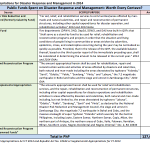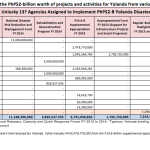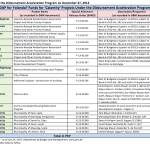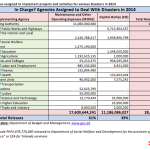AS DONATIONS continue to pour in from both local and foreign individuals and institutions for post-Yolanda recovery and rehabilitation efforts, the Philippine government has also loosened its purse strings and released funds to aid the typhoon-struck communities.
Indeed, when the nation marked the deadly super typhoon’s first anniversary on Nov. 8, 2014, the Department of Budget and Management (DBM) trumpeted its efforts, saying it had already released a total of PhP52.06 billion to bankroll relief, rehabilitation, and reconstruction projects and programs for Yolanda’s survivors.
Such massive funds outflow, Budget Secretary Florencio ‘Butch’ Abad said in a statement, showed that “the national government has made great strides this past year to help the people affected by (Yolanda), especially in Leyte and Samar.”
“We had to ensure,” he said, “(that) there were enough funds to support the rescue and reconstruction efforts and that these funds were released as quickly as possible.”
By now, the destruction wrought by the strongest typhoon ever recorded in modern Philippine history has been well documented. In its wake, Yolanda had left at least 6,200 killed, 28,600 injured, and thousands more still buried in the rubble. Some 550,900 houses were destroyed and 589,400 more were damaged.
In all, almost 16 million people were affected in 591 towns and 57 cities in 44 of the country’s 80 provinces. These figures are based on the National Disaster Risk Reduction and Management Council’s (NDRRMC) situational report dated April 3, 2014.
PhP167-billion bill
The Comprehensive Rehabilitation and Recovery Plan or CRRP, consolidated by the office of then Presidential Assistant for Rehabilitation and Recovery (PARR) Secretary Panfilo ‘Ping’ M. Lacson, has envisioned a PhP167.9-billion funding requirement to rebuild the affected areas until 2016. It’s a whopping figure, yet coming up with the needed money seems to be surprisingly easy.
Some 58 foreign governments and the European Commission alone have already given some PhP29.84 billion or US$ 667.5 million as of October 2014, according to donor documents. Combined with the total releases from the public coffers for Yolanda as of November 2014, the funds and donations add up to PhP81.89 billion in all.
The massive sum, distributed directly across the nation, would have meant that every one of about 100 million Filipinos should have obtained P819 each. The same total, applied to civil works contracts, would have secured the nation a total of 75,000 classrooms, 80,000 health centers, 45,000 public markets, 7,800 kilometers of concrete roads, according to the standard contract price for civil works projects of the Department of Public Works and Highways (DPWH).
At an assessment forum on Yolanda held in November 2014, Abad also guaranteed that the balance of the PhP167.9 billion would be made available in the 2015 and 2016 budgets — PhP80.31 billion and PhP38.93 billion, respectively, which in fact means a little bit more that the projected expense.
“Money is not a problem,” Abad said. “The problem is the assessment, preparation, execution, and delivery (of aid).”
Abad could not have described the situation more accurately. When PCIJ sat down to unpack and parse the government’s numbers, the big data did seem impressive. The small data, however, tended to belie the government’s claims that public funds have so far been released fairly, quickly, and efficiently, and for all the right purposes, to the communities ravaged by Yolanda.
Aid workers and government officials themselves interviewed by PCIJ admit that the flow of disaster aid has been caught up in bureaucratic maze, tainted by partisan politics, impaired by uneven absorptive and technical capacities on ground, and hobbled by the disconnected and inchoate operations of the concerned national and local government agencies.
Mercy missions?
A lot of money has apparently failed to make the government any smarter or more constant and consistent in its efforts to manage disasters beyond its usual resort to mounting virtual mercy missions for the hapless victims – with publicity stunts for public officials tucked in between.
It does not help that when the DBM releases appropriation documents, the funds do not flow as promptly and the projects do not roll out as quickly. Project planning and implementation result in back-and-forth arguments between agencies, and the bidding process is often long and arduous.
Another complication comes from the government having yet to complete its recovery and reconstruction efforts for prior episodes of typhoons, flashfloods, earthquakes, and other calamities – including the September 2013 Zamboanga siege – that visited the country even as far back as 2011. Funding requirements for these would piggyback on the supplemental budget secured mainly for Yolanda.
Tracking government funds for Yolanda proved to be as difficult – if not more so – as monitoring foreign donations for the super typhoon’s survivors. Many agencies are stingy with data; as of this writing, PCIJ has pending requests for information with the Departments of Education, Health, and Trade and Industry, DBM, and the Bureau of the Treasury.
Conflicting figures
Yet even if the data are available, they are often confusing and contradictory. For instance, the Department of Social Welfare and Development (DSWD), which received by far the largest share of disaster funds, gave conflicting data on the amount of money it had spent on emergency shelter assistance.
An official reply to PCIJ’s queries from the Office of Secretary Corazon ‘Dinky’ Soliman said that as of last Nov. 28, DSWD has used more than P4.96 billion for the distribution of relief goods, cash-for-work scheme, core and emergency shelter assistance, financial assistance, and provision of “kitchen/cooking utensils for supplemental feeding.”
Of the amount, PhP378.29 million went to emergency shelter assistance or ESA to Yolanda’s victims. But an office under Soliman, in another communication, told PCIJ that DSWD has released PhP3.18 billion in ESA alone as of December 2014.
DBM, for its part, has uploaded three different databases on its official website related to disaster aid. The total releases in 2014 amounted to PhP31.3 billion. This consisted of PhP13 billion for releases under the 2014 Calamity Fund (now called National Disaster Risk Reduction and Management Fund), PhP10.9 billion from the supplemental appropriation, PhP2.48 billion released to DSWD, and PhP4.9 billion from the 2014 rehabilitation and reconstruction program.
But specific data are neither available nor accessible from the DBM website covering at least PhP7.24 billion of Yolanda disaster funds sourced from “Regular Budget and Realignments in FY2013 and 2014”; PhP19.58 billion from “Overall Savings FY 2013”; and PhP2.16 billion from “Automatic Appropriations FY 2014.” In all, these amounts without specific project information total PhP28.98 billion.
Trail turns thin, cold
In addition, other than data regarding which line departments received how much, the DBM disbursements trail turns thin and cold. There is hardly sufficient information on the identities of the final beneficiaries (towns, provinces, villages, etc.), or more importantly, the exact location and final deliverables or outcomes of projects.
Then, too, the bulk or 61 percent of DBM’s total releases for disaster relief are listed as having gone to Maintenance and Operating Expenses (MOOE), which by nature are difficult to account for; only 39 percent are recorded as having gone to Capital Outlay (CO), which is more concrete and requires full documentation.
According to DBM’s own official Glossary of Terms, “Maintenance and Other Operating Expenses refer to expenditures to support the operations of government agencies such as expenses for supplies and materials; transportation and travel; utilities (water, power, etc.) and repairs, etc.”
It also says, “Capital Expenditures or Capital Outlays refer to appropriations for the purchase of goods and services, the benefits of which extend beyond the fiscal year and which add to the assets of the Government, including investments in the capital stock of GOCCs and their subsidiaries.”
As for the PhP52.06 billion that DBM says the government has spent so far on disaster-relief operations, Abad himself had said in a statement that the amount had come from various funds enrolled in budget years 2012, 2013, and 2014.
DBM also gave a further breakdown of the sources of the PhP52.06 billion:
• Overall savings, PhP19.58 billion;
• Special Purpose Funds, PhP17.86 billion;
• Regular and realignments within agency budgets, PhP7.24 billion;
• P14.6-billion supplemental appropriations, PhP3.51 billion;
• Automatic appropriations, PhP2.16 billion; and
• Unprogrammed funds, P1.71 billion
About 75 percent of the PhP52.06 billion was released supposedly only on the President‘s approval.
Traces of DAP, again
DBM has yet to clarify, however, whether the overall savings it culled from the 2013 budget also refer to the controversial Disbursement Acceleration Program (DAP). In July 2014, the Supreme Court had voted 13-0-1 to declare parts of DAP unconstitutional.
The last DAP tranche — PhP4.1 billion in all — was released by DBM on Dec. 27, 2013. Interestingly, on that day, Special Allotment Release Orders (SAROs) included over PhP3 billion for “Calamity-Related Rehabilitation Restoration Project and Other Priority Projects” coursed through the Civil Aviation Authority of the Philippines (CAAP), Tourism Infrastructure and Enterprise Zone Authority (TIEZA), National Dairy Authority (NDA), National Irrigation Authority (NIA), and Philippine Coconut Authority (PCA). Direct assistance worth PhP23.33 million was also provided to the mostly Liberal Party-affiliated mayors of Palo, Javier, and Mayorga towns in Leyte province, and Santa Fe town in Cebu, as well as those in Manaoag in Pangasinan, and Lemery in Iloilo.
(SAROs are documents issued by DBM that trigger the release of special purpose funds for expenditure items that are not listed in the General Appropriations Act or the national budget.)
Complicating any analysis of DBM documents is their use of sparse and general language that does not reveal useful information about the projects. In fact, at least 11 percent of releases under the supplemental appropriations had no project description. About PhP2.3 billion of the other disaster funds had entries of just “rehabilitation and reconstruction program” as project description.
In the case of the Department of the Interior and Local Government (DILG), a PhP4.49-billion allocation was explained thus: PhP2.41 billion for the “release of funds for the recovery and rehabilitation requirements of Bohol and Cebu devastated by magnitude 7.2 earthquake,” PhP2 billion for the “recovery and rehabilitation assistance for Typhoon Yolanda,” and PhP72.4 million for “project administrative cost.”
Then there was the Department of Transportation and Communication (DOTC), which was allotted PhP52.6 million for the “release of funds to cover payment and expenditures incurred during relief operations for Typhoon Yolanda.”
Considering the massive undertaking planned for the Yolanda-hit areas, as well as the amounts of money involved, transparency should have been a given for releases and disbursements for Yolanda activities.
More, more money
In December 2013, for example, the executive branch received as supplemental appropriation some PhP14.6 billion after it made an appeal for such in the name of Yolanda survivors “and other natural and man-made calamities.” Yet again in December 2014, the government sought and secured another PhP22.5 billion in supplemental appropriation, partly also for Yolanda’s victims and disaster assistance.
As of Oct. 31, 2014, DBM said all that was left of the first supplemental appropriation of PhP14.6 billion was PhP293,156,354.
DBM said the released amount was coursed through over a dozen implementing agencies, notably DSWD, DILG, DOTC, and the Departments of Agriculture, Labor and Employment, Education, Finance, Health, Justice, Science and Technology, and Trade and Industry, as well as the Commission on Higher Education. Portions of the money were implemented by LGUs themselves, including certain municipalities in Misamis Oriental, Zambales, and Kalinga and the province of Albay, according to DBM.
The biggest shares of the supplemental budget went to DPWH (PhP5.45 billion, all as capital outlay); DSWD (PhP3.4 billion, all MOOE); DILG, (PhP2.49 billion); Department of Agriculture (PhP1.2 billion, split between PhP1.1 billion for MOOE, and PhP1 million for CO); and Department of Labor and Employment (PhP892 million).
The Department of National Defense, which chairs the NDRRMC and also supervises the Office of Civil Defense, got zero funding.
Not all for Yolanda
Yet DBM documents themselves reveal that of the PhP14.6 billion, less than a fourth or just PhP3.39 billion were released for the communities ravaged by Yolanda.
The bigger balance of about PhP7.5 billion actually went to all sorts of unnamed communities in the provinces visited by a long parade of typhoons with names few people would still remember. (See Sidebar: A throng of typhoons)
These include communities damaged by Dante, Emong, Isang, Jolina, Kiko, Labuyo,Vinta, Maring, Quedan, Ramil, Santi, Zoraida, Odette, “previous disasters and aggravated by Typhoon Yolanda,” Habagat, “monsoon rains,” and “flashfloods” in 2013, which received PhP3.761 billion or more than that allotted for Yolanda-affected areas.
DBM said though that its data exclude expenses under DSWD’s PhP3.4-billion Quick Response Fund for Yolanda victims, which was also sourced from the first supplemental budget.
In the meantime, speed soon went missing after the government secured the lawmakers’ approval of its request for additional monies. While it seemed to be in a rush when it made its appeal to Congress, the executive branch appeared to turn lethargic in releasing and using the funds to get goods and projects delivered to disaster victims.
Late billing
The first billing on the first supplemental budget was for PhP1,045,569,785 that a DBM SARO dated March 4, 2014 said was “to cover funding requirements for the Reconstruction Assistance for Yolanda-affected farmers, pursuant to approval of the Office of the President dated December 27, 2013.” But the quoted date is even off by five days; the President signed the supplemental budget into law on Jan. 2, 2014.
The day of the President’s signing was also exactly 49 days after Yolanda struck. But the delay in the release of funds stretched on for much longer. The next SAROs billed on the budget came on March 7 and 24, 2014 for the “implementation of Disaster Victims Identification (DVI)” and repair of roadside structures and government buildings in Cebu. Then came a billing for “emergency employment and livelihood assistance” on April 8, 2014, or exactly five months after Yolanda struck.
Other DBM SAROs covering expenses sourced from the PhP14.6-billion supplemental budget came on April 24; May 9, 12, 21, 23, and 26; June 4 and 10; July 2, 4, 15, 23, and 31, and August 11, 2014.
On May 26, 2014, DBM also had separate SARO releases amounting to PhP2.41 billion that were channeled through DILG and which represented the bulk of the department’s share of the supplemental budget. The remainder of DILG’s share was covered by another SARO for PhP72.4 million for “Project Administration Cost.”
DILG’s slice of the supplemental pie was listed in DBM’s books as MOOE. It was meant not for Yolanda-related activities, but for the government of Bohol, which was jolted by a 7.2-magnitude earthquake in October 2013.
On Dec. 17, 2014, Congress granted another request from the executive branch for a second executive supplemental budget, this time to the tune of PhP22.5-billion. Some PhP8 billion of the amount has been proposed to go to the National Housing Authority (NHA) for the construction of new shelters for Yolanda survivors. Another P2.1 billion will go to DSWD for emergency shelter assistance for Yolanda survivors.
And yet as late as September 2014, the Commission on Audit (COA) released a report on disaster funds that noted that the government still had millions of pesos of unspent disaster funds.
Liberty with funds
Congress had earlier allowed the Palace more budget authority to release disaster-assistance funds: a total of PhP127.6 billion from various sources for calamities and disasters that struck the country in 2013 and 2014. The sum excludes the departments’ regular programs and projects initially allocated and set to be implemented in areas affected by Yolanda, as well as the local government units’ share in the national coffers or the Internal Revenue Allotment, and the available balance of the 2013 budget.
In the 2014 budget, the Calamity Fund nearly doubled to PhP13 billion. A new PhP20-billion lump-sum fund named “Rehabilitation and Reconstruction Program” was also created in 2014. Another PhP80 billion were set aside under “unprogrammed funds,” which would be released only when new revenues are identified.
Too, the government has drawn funds for disaster relief, rehabilitation, and reconstruction efforts from various other public purses or special-purpose funds, including the last tranche of DAP. In addition, the government initially promised that the Contingency Fund and President’s Social Fund would be used for relief and rehabilitation in the aftermath of Yolanda.
In December 2013, the government had also secured PhP44 billion in loans from multilateral institutions. A US$500-million loan from the World Bank was to assist the government in “addressing the unanticipated financial gap caused by the unprecedented magnitude of the typhoon, which could jeopardize the government’s reform program.” Another US$500-million loan from the Asian Development Bank was intended to finance the government’s disaster-related expenses, particularly livelihood and economic ones, which were enrolled in the 2013 and 2014 expenditure programs.
Too little, too slow
But the government did not only underspend, it also spent slowly and even, by many accounts, inappropriately and with not so good results.
As of November last year, releases under these funds went below appropriations, with only PhP31.3 billion or less than a quarter of the PhP127.6 billion of disaster monies reportedly released. That PhP31.3 billion included a substantial amount for recovery efforts from damage wrought by almost a dozen calamities three to four years past. It also covered at least PhP262.69 million for recovery efforts in areas that were not directly affected by the typhoons indicated in official documents.
As it turned out, at least one lawmaker seemed to be paying attention to all these. Before Congress approved the Executive’s request for a second supplemental budget, Senator Miriam Defensor-Santiago asked why Malacañang was seeking another supplemental appropriation when it had yet to spend up to PhP274 billion out of the PhP1.73-trillion appropriation that Congress authorized in the first three quarters of 2014.
Santiago noted that supplemental appropriations are passed during “extreme crisis when the government has to step up public spending in order to avoid a major economic downturn,” or “in times of grave natural calamities like a major earthquake or killer typhoons when the existing budget may be inadequate to finance urgent reconstruction work”
Remarked the senator: “[Budget Secretary Abad] appears to be asking Congress to legitimize his illegal acts, making members of Congress accomplices in the act of circumventing the Supreme Court decision on the DAP.”
” – PCIJ, January 2015
DATA TABLES
Acknowledgment:
“Christian Aid funded this project/report as our contribution to the interest of the public’s right to know how the Yolanda funds are managed and used, and that the findings and recommendations are meant to feed into the policy discourse on Republic Act No. 10121 (The Philippine Risk Reduction and Management Plan of 2010) review and the Yolanda budget process.”





